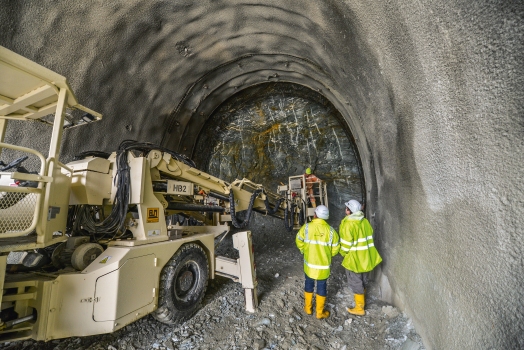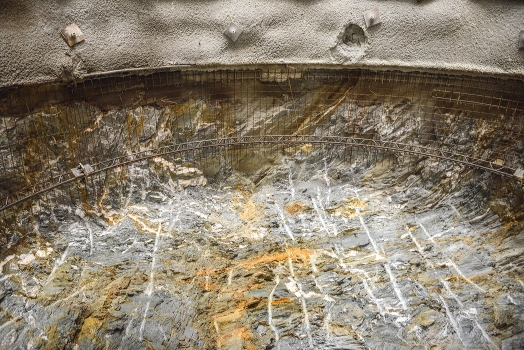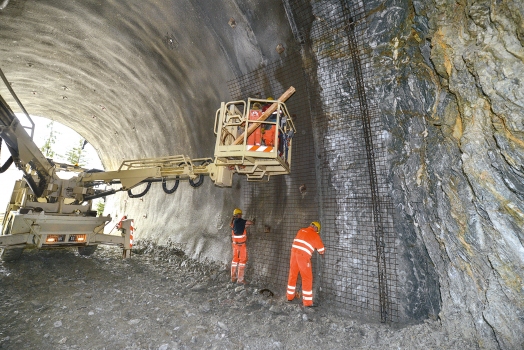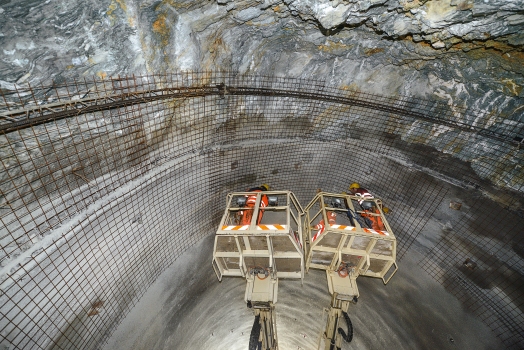Hydroelectric power plant Inn – More than 400GWh of energy from water
The GKI at the upper Inn River in the area of the Swiss-Austrian border is the largest run-of-river installation that is being built in the Alps in this millennium. Once the construction phase of approx. four years from 2014 to 2018 will be over, the new plant will generate more than 400 GWh of energy from the renewable resource water every year. Basically, the plant consists of a retaining area, a weir system, a head race tunnel and a power house.
Media
The 15 m high weir system for water retention is being built in the border area between Martina and Nauders. Up to 75 m³/s of the retained water will be diverted into the 3.2 km long headrace tunnel. This tunnel discharges into the pressure tunnel which, in turn, leads toward the turbines in the power house in Prutz/Ried. Here, two powerful hydroelectric generating sets consisting of a Francis turbine and a generator each produce environmentally-friendly electricity.
Below Martina near Inn, at km 413.84, near the Ovella farm building, a two-section weir is being built for the power plant. By retaining the Inn River via this weir system, an approx. 2.6 km long retention area is being created. The beginning of the retention area backwater reaches back as far as the Inn Bridge in Martina. The water that is drawn through the intake near the weir system reaches the GKI power house in Prutz via the intake waterway.
23 km long underground head race tunnel
The intake waterway consists of an approx. 23 km long underground head race tunnel and a power descent that is being built as an inclined chute. The outflow towards the surge shaft is located in front of the transition from the head race tunnel to the inclined chute. Due to its long length and in order to permit high rates of advancement, the intake waterway was excavated using Tunnel Boring Machines (TBM). In addition, several access galleries, access tunnels and starting ranges are being cyclically excavated by blasting.
The northernmost part of the head race tunnel is also being advanced using the cyclical full-circle tunnel heading method and will be stabilized by a double lining. The outer lining consists of reinforced shotcrete with rock bolts and steel arches. The inner lining is a cast-in-place concrete ring that is partly fitted with a sealing sheet.
Before the head race tunnel could be excavated, an access gallery had to be built using the blasting method. The gallery, which features a 17 degree incline, will transport the water from the head race tunnel to the powerhouse.
For advancing the different tunnels and access galleries as well as the inclined chute, DSI Austria supplied the complete range of ground support products that were needed. This mainly included 120 kN, 3 and 4 m long OMEGA-BOLT® Expandable Friction Bolts with anchor plates and sleeve tubes as well as Type SN25-250 Anchors in lengths of 4 and 6 m with special ALWAGRIP rib geometry including 200/200/10 mm anchor plates, nuts and washers. Furthermore, DSI supplied the R32-250 and R32-280 Ø DYWI® Drill Hollow Bar System in lengths of 2, 3 and 4 m; 25 mm Ø BST 550 steel spiles; R32 self-drilling spiles in lengths of 3 and 4 m including hardened drill bits as well as Types 130/20/30 and 70/20/30 PANTEX Lattice Girders with welded-on nut pairs and spacers.
Structure Types
- About this
data sheet - Product-ID
7349 - Published on:
11/05/2016 - Last updated on:
17/11/2021






